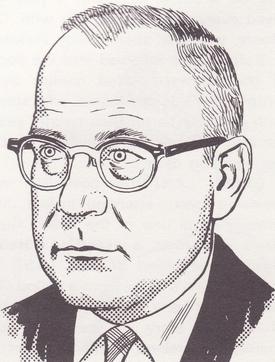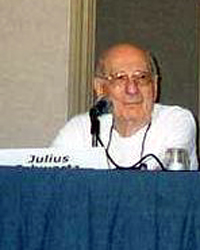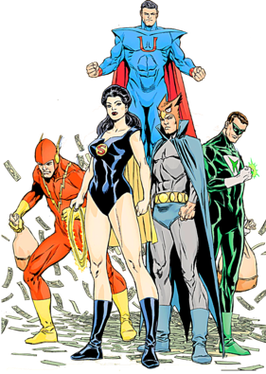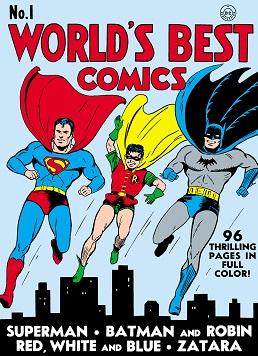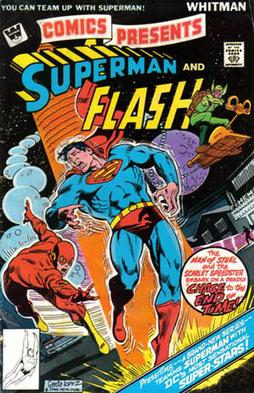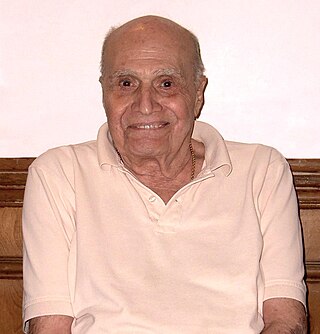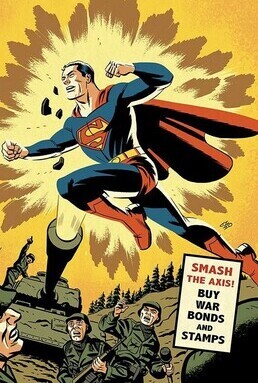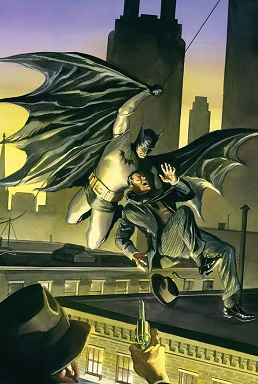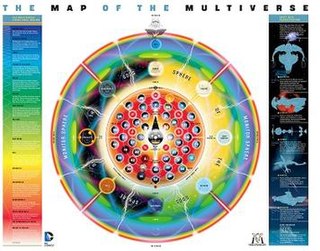Pre-Crisis version
Flash of Two Worlds

Characters from DC Comics were originally suggestive of each existing in their own world, as superheroes never encountered each other. This was soon changed with alliances being formed between certain protagonists. Several publications, including All-Star Comics (publishing tales of the Justice Society of America), Leading Comics (publishing tales of the Seven Soldiers of Victory) and other comic books introduced a "shared-universe" among several characters during the 1940s until the present day.
Alternative reality Earths had been used in DC stories before, but were usually not referred to after that particular story. Also most of these alternative Earths were usually so vastly different that no one would confuse that Earth and its history with the so-called real Earth. That would change when the existence of another reliable Earth was established in a story titled "Flash of Two Worlds" [3] [4] in which Barry Allen, the modern Flash later referred to as Earth-One (the setting of the Silver Age stories) first travels to another Earth, accidentally vibrating at just the right speed to appear on Earth-Two, where he meets Jay Garrick, his Earth-Two counterpart.
Major events
- More Fun Comics #101 (1945): the first appearance of Superboy. [5] According to canon, the Superman of Earth-Two did not fight crime until reaching Metropolis as an adult, therefore this is the first appearance of Earth-One in comics.
- Superman #76 (1952): the first appearance of the Earth-One Batman, teaming up with what must be Earth-One Superman. The two crime fighters meet for the first time in this story. [6] Their Earth-Two counterparts knew each other from their time in the Justice Society of America in the 1940s ( New York World's Fair Comics #2 (July 1940) contained the first published picture of Batman (Earth-Two) and Superman (Earth-Two) together).
- Superman's Pal Jimmy Olsen #1 (1954): debut issue of spinoff title for supporting character from the Superman series. [7] Superman and Batman books unofficially switch from the Earth-Two characters to the Earth-One characters, though it was not apparent at the time.
- Detective Comics #225 (1955): the first appearance of J'onn J'onzz, the Martian Manhunter. [8]
- Showcase #4 (1956): popularly the first Earth-One comic (though not mentioned in text as such), featuring the introduction of Barry Allen as The Flash. [9]
- Adventure Comics #246 (1958): unofficially the first appearance of Earth-One Green Arrow. [10]
- Wonder Woman #98 (1958): unofficially the first appearance of Earth-One Wonder Woman. [11] (See also Wonder Woman (Earth-Two).)
- Adventure Comics #260 (1959): the first appearance of Earth-One Aquaman. [12]
- Showcase #22 (1959): the first appearance of Hal Jordan, the Green Lantern of Earth-One. [13]
- The Brave and the Bold #34 (1961): the first appearance of Katar Hol, the Hawkman of Earth-One. [14]
- The Flash #123 (1961): "The Flash of Two Worlds", a story in which Barry Allen meets Jay Garrick. This is the first story to explain the concept of the Multiverse, namely that the two Flashes inhabited separate but similar Earths. [3]
- Showcase #34 (1961): the first appearance of Ray Palmer, the Atom of Earth-One. [15]
- Justice League of America #21 (1963): "Crisis on Earth-One", the first team-up between the JLA and the JSA, which became a yearly feature in the Justice League of America comic. This is the story in which both Earth-One and Earth-Two were first given names. [16]
- Green Lantern (vol. 2) #85 (1971): "Snowbirds Don't Fly", a story focusing on drug addiction, showing Green Arrow's ward Roy Harper addicted to heroin. [17] The story won the 1971 Shazam Award for Best Original Story.
- Justice League of America #100 (1972), the story that establishes that the Green Arrow and Speedy appearing in the 1940s were the Earth-2 Green Arrow and Speedy. This annual JLA/JSA team-up featured the return of the Golden Age superhero team the Seven Soldiers of Victory, of which the Golden Age Green Arrow and Speedy were members. [18] [19] [20]
- Swamp Thing #1 (1972): the first adventure of Alec Holland, the Swamp Thing. [21] The story won the 1972 Shazam Award for Best Original Story.
- Justice League of America #244 and Infinity, Inc. #19 (1985): the final team-up of the Justice League and the Justice Society before Earth-One and Earth-Two are merged. [22] [23]
- Crisis on Infinite Earths #10 (1986): The issue in which Earth-One, Earth-Two, Earth-Four (the home of the Charlton Comics heroes), Earth-S (the home of the Fawcett Comics heroes), and Earth-X (the home of the Quality Comics heroes) were combined into one reality, known as New Earth. [24]
- DC Comics Presents #97 (1986): "Phantom Zone: The Final Chapter", the last official Earth-One story. [25]
- Superman #423 and Action Comics #583 (1986): "Whatever Happened to the Man of Tomorrow?", the last story of the Superman of Earth-One, [26] though it is classified as an Imaginary Story and not an official Earth-One story. It features cameos by several other Earth-One heroes. [27] [28]
Destruction
Crisis on Infinite Earths (1985–1986) was an effort by DC Comics to clean up their continuity, resulting in the multiple universes, including that of Earth-One, combining into one. This involved the destruction of the multiverse, including Earth-One and the first appearance of the post-Crisis Earth.
